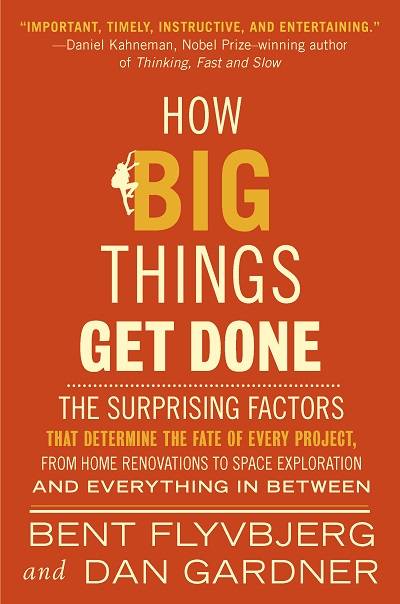Book review: How Big Things Get Done by Bent Flyvbjerg and Dan Gardner (Penguin Random House, 2023)
We don’t need to look at detailed statistics to know that large-scale projects often go drastically over their construction budgets: we see new examples every day. But Flyvbjerg and Gardner have a lifetime of research that not only provides examples of past disasters (more than 90 per cent of their database projects went over time or over budget) but suggests how to do better. Australia needs this wisdom, for climate and defence above all.
For public sector projects, the basic issue is the decision process. Political decisions are distorted by vested and single-issue interests. Ideally, the political process would impose technical and budget discipline. More often, the outcome is delay, revisions, compromise and – a key problem – projects beginning with inadequate detailed planning.
Proponents inevitably underestimate costs and difficulties; they want the project to go ahead – Kahneman’s optimism heuristic in spades.
Project decisions are routinely rushed because of political timetables mingled with the psychology of power. The authors’ prime example of a planning disaster – the Sydney Opera House – went fourteen times over budget and three times over time. The decision was rushed because the then-premier wanted commitment before his impending death.

Private sector projects don’t do much better (although they can often escape publicity). Even the currently favoured approach of outsourcing implementation of public infrastructure projects to the private sector often goes off the rails, usually on coordination and risk-sharing between public and private.
Is there something intrinsic in big projects that makes over-runs of budget and time inevitable, so we should either just reconcile ourselves to this, or never do big projects?
No need for such pessimism. The authors can quote some successes. Their favourite is the Empire State Building, which was built in a year and came in 17 per cent under budget. The main lesson they take here is that the technology was stock-standard, each floor being much the same as the others. Workers rapidly gained experience, completing successive floors more quickly as the building progressed. Did this deliver a dull stock-standard building? Not at all; while the Empire State is no longer the tallest, it is still iconic, nearly a hundred years later.
There are other successes. They quote the extraordinary achievements of Denmark in establishing its wind turbine industry; a country of five million people can lead the world, provided it draws on existing knowledge and European-wide suppliers. This, too, is the lesson of Dutch firm ASML, the leader in very advanced lithography machines used in silicon chipmaking, closely integrated with high-tech suppliers across Europe. The Boeing 747 is often quoted as another example of a big project that went well. There was meticulous pre-planning and deep experience from making large bombers.
The focus of How Big Things Get Done is on the construction phase of projects; the success of a project over its whole lifetime is a different issue. After its speedy build, the Empire State Building was a commercial failure, not fully tenanted until after the Second World War. On the other hand, the Sydney Opera House shrugged off its construction excesses to become a priceless icon.

What do the authors suggest to break the dismal record of construction over-runs?
First, use well-established technology. The temptation (particularly for politicians) is to specify that the project must be the best, the biggest and with cutting-edge technology, as a memorial to their own time in power.
Second, modular technology is superior to bespoke once-off innovation; look at the revolution containers brought to shipping through modularity. Solar panels are the cheapest electricity source; large-scale solar farms can be installed quickly because of modularity.
Third, experience is vital. The workers on the Empire State Building gained experience as the building rose. Experience allows production costs to fall with scale. This was the key to Japan’s automobile success, where factory-floor advice was quickly incorporated into the production process.
Fourth, use seasoned experts. Tendering for the cheapest supplier often turns out to be more expensive.
Fifth, do detailed planning beforehand and don’t commit too early (initial construction at the Sydney Opera House had to be demolished). “Think slow, act fast.”
Sixth, beware the “sunk cost” fallacy; sometimes, projects should be abandoned. Learn from failure, including other people’s.
Seventh, combat chronic over-budget cost blowouts by using Reference Class Forecasting. Projects are never as unique as proponents think. Get finished costings of similar projects done elsewhere (the authors’ own database has 16,000 projects). These will compensate not only for the standard optimism bias, but will also include a share of the known unknowns and even Rumsfeld’s unknown unknowns.
Eighth, and perhaps the most interesting, is the authors’ analysis of the degree of difficulty of projects. They rate project types by the distribution of cost over-runs, identifying “fat tails” where the projects not only ran over budget, but dramatically so. At the easy end are solar, wind, electricity grid, fossil-fuel generation, and roads. At the hard end are nuclear, Olympic Games, IT, hydro, and defence. These projects not only go wrong more often, but the blowouts are larger.
These insights have widespread application for Australia, but nowhere more so than in the climate debate and in defence procurement.
If nuclear has any future in the Australian electricity grid, it will be in the form of Small Modular Reactors, rather than large-scale conventional reactors. Australia can wait for others to gain the necessary experience; construction of what was anticipated to be the first commercial reactor has just been cancelled in the United States.
As for the AUKUS submarines, this project breaks every criterion of Flyvbjerg and Gardner: the decision was rushed on political grounds without detailed analysis; Australia has no experience and little established relevant supply-side industry; the technology is very complex with the highest degree of difficulty; and it is bespoke, with little modularity nor opportunities of scale through export.
Main photo from Unsplash user Christian Ladewig.

